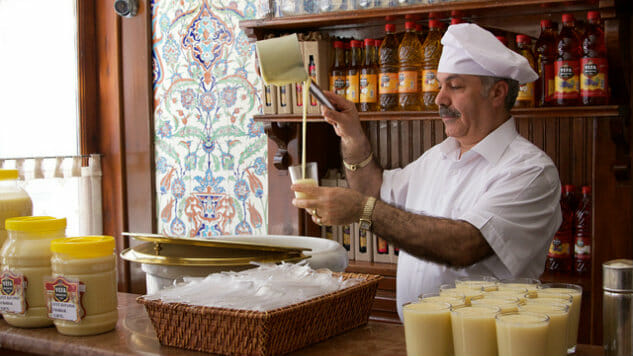
Tea is the lifeblood of Istanbul. Whether riding a ferry across the Bosphorus, enjoying a leisurely breakfast with friends, or sitting down to do business, cup after cup of the slightly bitter Turkish brew is sure to be proffered.
Yet despite its ubiquity in today’s Turkey, tea was more of a novelty when the region was under Ottoman control. Coffee was the social lubricant of choice for Ottomans, who were also known to regularly quaff boza, a fermented millet beverage, and salep, a hot drink made from milk and orchid tubers. The raucous bozahane (boza house) and the cultured kahvehane (coffeehouse) may, like the Ottoman Empire, be a thing of the past, but the age-old libations they served can still be found in Istanbul.
It’s generally accepted that coffee was introduced to Istanbul in the mid-16th century, when traders from Syria opened the city’s first coffeehouse and began serving an unfiltered coffee made by simmering finely ground coffee beans in a cezve (small copper pot). Suddenly, there were spots outside of the home that were suitable for socializing and idling away time, marking a shift in the Ottoman social fabric. Men of different social classes came together in coffeehouses to watch Karagoz (shadow puppet) performances and listen to the tales told by traveling poets, all while drinking tiny cups of Turkish coffee.
In the 18th and 19th centuries, the coffeehouses famously became hotbeds of dissent. Janissary troops congregated in certain establishments and, being armed and generally dissatisfied, they had the capability to change governments. The infamous Patrona Halil Rebellion of 1730, which ultimately dethroned Sultan Ahmed III, was sparked in a Janissary coffeehouse.
Although coffeehouses still exist in name, they rarely serve the brown stuff. The unadorned, fluorescent-lit rooms are meeting points for older Turkish men to drink tea and while away their hours playing games (as opposed to plotting ousters). Turkish coffee is readily available at Istanbul’s cafes and restaurants, but it’s best at the smaller, no frills spots. Located in a small alley off Istiklal Caddesi, Beyoglu’s main pedestrian thoroughfare, Mandabatmaz is one of the few places to still use custom roasted beans, while Okkali Kahve, a small café in Besiktas, does a mean Turkish coffee with milk.
Tasting Turkish coffee doesn’t require much effort, yet boza and salep are harder to come by in Istanbul. To begin with, the two drinks are only served in the winter months. Boza in particular is difficult to find, despite its storied history.
Made from fermented grains, boza is a beverage with ancient roots in Anatolia – archaeologists believe that the Sumerians and Hittites indulged in some form of it. Two types of boza were prominent during the Ottoman Empire: “sweet boza,” which contained very little alcohol, and “fermented boza,” sometimes called “Tatar boza,” which had an alcohol content to rival wine. The former was permissible, a sugary treat to be shared with family and neighbors on a winter evening, while the latter was banned time and time again over the centuries, to little effect.
The taverns (bozahane or “boza house”) that sold fermented boza attracted soldiers, sailors, porters, and other working-class men. Not only did boza fortify these workers and satisfy their hunger, but it also allowed them to let loose. According to the 17th-century traveler Evliya Celebi, the fermented boza from the Crimea was so strong that a single glass caused a man to burst into song. While a gentleman would visit a bozahane every so often for a kebab and a tipple of boza, it was considered uncouth to be a regular.
Fermented boza may have gone out of favor, but there is one shop in Istanbul that still serves sweet boza. Vefa Bozacisi, located in the rundown neighborhood between Suleymaniye Mosque and the Valens Aqueduct, is a diamond in the rough. Opened in 1876 by an Albanian family, the store oozes old world glamour with its Iznik tiles, glittering mosaic columns, and dark wood furniture. The immaculately coifed waiters use a large traditional ladle to scoop boza from a marble basin into a glass cup. Topped with roasted chickpeas and cinnamon, the boza has the consistency of a thick soup and is best eaten with a spoon. The tangy-sweet beverage is definitely a strange brew.
More common than boza, salep (also written as sahlep) is a winter staple in Istanbul. The main ingredient is salep flour, which is made from the dried roots of a type of wild Anatolian mountain orchid. During the Ottoman Empire, salep flour was often mixed with milk, rosewater, and sugar to create the popular drink. An alleged aphrodisiac, salep flour was also added to the halva, a sweet made of sesame flour and honey, and ice cream prepared at the Ottoman court.
Much of the salep flour produced in Turkey today is used in maras dondurmasi, a thick, chewy ice cream. So as wild orchid supplies dwindle, salep in its beverage form is more often made with cornstarch and salep flavoring. Yet even with these impurities, salep is still a tasty treat. In winter, street vendors wheel around carts with large brass samovars full of the gooey beverage. The extra sweet, eggnog-like drink they pour into paper cups and top with a dusting of cinnamon has the consistency of a thin pudding.
Salep can also be found at most cafes in Istanbul, but only a few, like Ali Usta in Kadikoy, sell the pure stuff. While the unadulterated salep at Ali Usta is certainly silky smooth, the starchy salep sold on the ferry is equally sustaining. Plus, a ferry ride spent sipping creamy, sugary salep is a good reminder that there is more to Turkey than tea.
Emma Harper is an editor and writer based in Istanbul. A lifelong student of Ottoman history, she is the online arts editor of Cornucopia Magazine, a biannual glossy for connoisseurs of Turkey.
Header photo by Thomas Hubauer CC BY